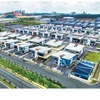The United Nations Food and Agriculture Organisation (FAO) forecasts that the Philippines’ rice import will rise 20 percent to 1.2 million tonnes next year due to damage caused by typhoon Haiyan.
The country’s rice output is predicted at 18 million tonnes this year, a fall of 5 percent from an earlier projection and 10 percent from the 20-tonne target set by its Government.
Typhoon Haiyan caused extensive damage in the Philippines and displaced over 4 million people. Thus, its Government may import more rice in the coming months to control domestic prices, FAO said.
Meanwhile, Undersecretary of the country’s Department of Agriculture Dante Delima said the 1.2 million-tonne import that FAO estimates is too high and more than the country’s needs. However, he declined to provide the exact volume to be imported next year.-VNA
The country’s rice output is predicted at 18 million tonnes this year, a fall of 5 percent from an earlier projection and 10 percent from the 20-tonne target set by its Government.
Typhoon Haiyan caused extensive damage in the Philippines and displaced over 4 million people. Thus, its Government may import more rice in the coming months to control domestic prices, FAO said.
Meanwhile, Undersecretary of the country’s Department of Agriculture Dante Delima said the 1.2 million-tonne import that FAO estimates is too high and more than the country’s needs. However, he declined to provide the exact volume to be imported next year.-VNA



















